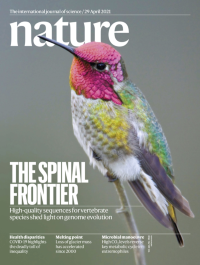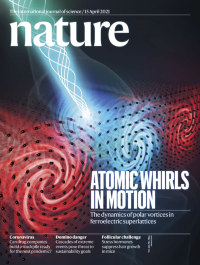Volume 592
-
No. 7856 29 April 2021
The spinal frontierThe Vertebrate Genomes Project aims to assemble high-quality reference genomes for all of the roughly 70,000 living vertebrate species, to address fundamental questions in biology, disease and conservation. In this week’s issue, the project takes a step towards that goal with the publication of a flagship paper that reports its first high-quality genomes for 16 species representing the major vertebrate classes, including mammals, birds, reptiles, amphibians and fishes. The researchers first evaluated sequencing and assembly approaches on an Anna’s hummingbird (Calypte anna, pictured on the cover) before applying the findings to assemble the other 15 genomes. The results have allowed the team to correct errors and add missing sequences to existing genomes, and to answer some questions on genome evolution and biology. In linked papers, which include additional genomes, members of the project suggest a universal nomenclature for the neurotransmitters oxytocin and vasotocin and their respective receptors based on genome analysis in vertebrates; they reveal the complex evolution of sex chromosomes in the platypus and short-beaked echidna; and they discover diverse relationships between maternal and paternal chromosomes in the common marmoset.
-
No. 7855 22 April 2021
Death of a starThe cover shows the supernova remnant Cassiopeia A. In the past few years, simulations have suggested that neutrinos might drive the explosion mechanism that leads to core-collapse supernovae such as Cassiopeia A. In this week’s issue, Toshiki Sato and his colleagues provide observational evidence that supports this mechanism. The researchers examined the iron-rich fingers of gas that protrude from Cassiopeia A and observed that they contain stable titanium and chromium. The abundances of these elements relative to iron mean that they must have formed in neutrino-driven plumes that helped to trigger the explosion that created the supernova.
-
No. 7854 15 April 2021
Atomic whirls in motionVortices of electrical polarization — similar to skyrmions found in magnets — have been seen in ferroelectric materials, but little is known about their dynamics. In this week’s issue, Haidan Wen and his colleagues probe the phenomenon and reveal the unique dynamical nature of these vortices. The researchers used ultrashort electric-field pulses in the form of terahertz radiation to create vortex motion in a ferroelectric film, and then used femtosecond X-ray diffraction to examine the movement of the vortices. They found that the polar vortices that are smaller than skyrmions have higher frequencies, and identified a tunable, low-frequency mode called a vortexon, which corresponds to collective atomic motion arising from interactions between the vortices and the atomic lattice. The researchers suggest that the properties of the vortices could find application in ultrahigh-speed data processing.
-
No. 7853 8 April 2021
Less is moreAny attempt to improve an object, idea or situation involves a mental search for possible changes. In this week’s issue, Gabrielle Adams, Benjamin Converse and their colleagues reveal that people tend to solve these challenges by adding extra elements even when taking something away would be simpler and more advantageous. The researchers examined how people approached a range of problems, including solving a geometrical puzzle, stabilizing a Lego structure and improving a miniature golf course. They found that people typically default to searching for additive solutions and only consider subtractive solutions when they are able and willing to invest more effort. The team suggests that subtractive solutions are cognitively less accessible to people, and the fact we continually seek to solve problems by adding elements to them may help explain why we struggle to mitigate problems such as overwhelming schedules, excessive red tape and an overburdened planet.
-
No. 7852 1 April 2021
Laser-cooled antimatterLaser cooling — the use of photons to slow the movement of atoms — changed the face of atomic physics when it was first demonstrated 40 years ago. In this week’s issue, the ALPHA collaboration takes this technique into fresh territory by successfully applying it to antimatter. Working at CERN’s Antiproton Decelerator facility, the researchers trapped atoms of antihydrogen using magnetic fields and then irradiated them with carefully tuned pulses of a purpose-built, ultraviolet laser. This slowed some of the atoms down, thereby cooling them and reducing the width of a measured atomic transition in the anti-atoms. The researchers believe the technique should make it easier to investigate the fundamental properties of antimatter — including its gravitational behaviour. The cover shows a close-up of the end electrode of the gold-plated Penning trap that is used to capture and manipulate antiprotons and positrons to form the antihydrogen atoms.
Nature Outlook





